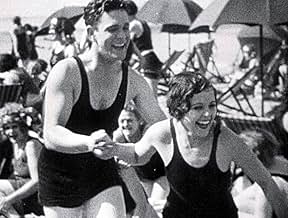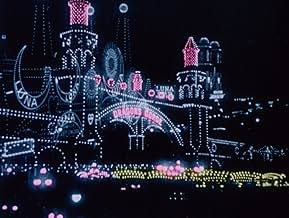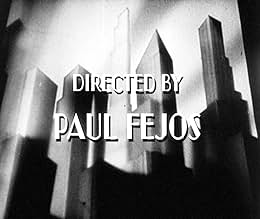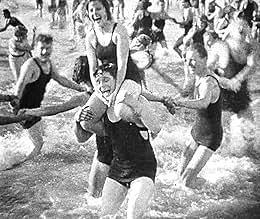IMDb RATING
7.7/10
2.8K
YOUR RATING
Two lonely people in the big city meet and enjoy the thrills of an amusement park, only to lose each other in the crowd after spending a great day together. Will they ever see each other aga... Read allTwo lonely people in the big city meet and enjoy the thrills of an amusement park, only to lose each other in the crowd after spending a great day together. Will they ever see each other again?Two lonely people in the big city meet and enjoy the thrills of an amusement park, only to lose each other in the crowd after spending a great day together. Will they ever see each other again?
- Awards
- 1 win total
Gusztáv Pártos
- Romantic Gentleman
- (as Gustav Partos)
Henry Armetta
- Ferris wheel guy
- (uncredited)
Edgar Dearing
- Cop
- (uncredited)
Louise Emmons
- Telephone Caller
- (uncredited)
Fred Esmelton
- Swami
- (uncredited)
Jack Raymond
- Barker
- (uncredited)
Churchill Ross
- Telephone Caller
- (uncredited)
Featured reviews
There are at least three levels at which 'Lonesome' is an extremely interesting film.
1. It is a sweet story of two lonely people in a big anonymous city who meet, fall in love and lose each other. The picture is well-acted, and the two lead actors Barbara Kent (Mary) and Glenn Tryon (Jim) are perfectly matched; they both give nuanced and sensitive performances.
2. The style of the picture is almost documentary, which makes it interesting from a social history point of view. In some ways, nothing much has changed over the last 100 years: People are still commuting to work, the subway in New York was as crowded as the London Underground is today (I don't know about New York in 2022), you get annoyed at the same kind of behaviour of your fellow passengers (e.g. Eating smelly food) etc. Obviously other things have changed: The type of work we do, for example, and we no longer bond over serialised novels published in newspapers that we read. Nevertheless, we are still living in what is recognisably the same kind of society. I found this aspect of 'Lonesome' particularly interesting.
3. Technologically, 'Lonesome' was highly innovative, being the perfect example of a film that came out during the transition phase from silent pictures to talkies to colour films. Initially, it looks like a normal black and white silent film to which music and some sound effects have been added. However, some scenes have spoken dialogue, and some are even in colour, or at least partly colorised. People back then must have felt they were living in an exciting age of innovation; I am sure they expected that within the next few years, all talking and maybe even all colour films would become the norm.
So why am I giving 'Lonesome' no more than 8 stars? Well, there are a few flaws. First, the dialogue sounds as stilted as if the actors were reading it from a sheet, and on top of that, a bit of it does not seem to make much sense (the scene at the police). It feels like an afterthought, like something director Pal Fejös inserted after having finished the rest of the film. Second, the colour effects are not particularly nice to look at. The colours are just garish. They were certainly innovative, but the film would look better without them. And finally, the plot is so simple that it barely exists. The only real problem the characters face appears almost at the end of the film, and its resolution does not logically follow from anything that happened earlier; it just comes about by chance. I am reserving 9 stars for pictures that are as good as perfect, and 10 for those that have some particular emotional quality or style that takes them into the small group of my favourite films (like e.g. 'North by Northwest', which for my taste must be one of the most stylish films ever made). 'Lonesome' is very good, but not as good as that. Hence 8 stars.
1. It is a sweet story of two lonely people in a big anonymous city who meet, fall in love and lose each other. The picture is well-acted, and the two lead actors Barbara Kent (Mary) and Glenn Tryon (Jim) are perfectly matched; they both give nuanced and sensitive performances.
2. The style of the picture is almost documentary, which makes it interesting from a social history point of view. In some ways, nothing much has changed over the last 100 years: People are still commuting to work, the subway in New York was as crowded as the London Underground is today (I don't know about New York in 2022), you get annoyed at the same kind of behaviour of your fellow passengers (e.g. Eating smelly food) etc. Obviously other things have changed: The type of work we do, for example, and we no longer bond over serialised novels published in newspapers that we read. Nevertheless, we are still living in what is recognisably the same kind of society. I found this aspect of 'Lonesome' particularly interesting.
3. Technologically, 'Lonesome' was highly innovative, being the perfect example of a film that came out during the transition phase from silent pictures to talkies to colour films. Initially, it looks like a normal black and white silent film to which music and some sound effects have been added. However, some scenes have spoken dialogue, and some are even in colour, or at least partly colorised. People back then must have felt they were living in an exciting age of innovation; I am sure they expected that within the next few years, all talking and maybe even all colour films would become the norm.
So why am I giving 'Lonesome' no more than 8 stars? Well, there are a few flaws. First, the dialogue sounds as stilted as if the actors were reading it from a sheet, and on top of that, a bit of it does not seem to make much sense (the scene at the police). It feels like an afterthought, like something director Pal Fejös inserted after having finished the rest of the film. Second, the colour effects are not particularly nice to look at. The colours are just garish. They were certainly innovative, but the film would look better without them. And finally, the plot is so simple that it barely exists. The only real problem the characters face appears almost at the end of the film, and its resolution does not logically follow from anything that happened earlier; it just comes about by chance. I am reserving 9 stars for pictures that are as good as perfect, and 10 for those that have some particular emotional quality or style that takes them into the small group of my favourite films (like e.g. 'North by Northwest', which for my taste must be one of the most stylish films ever made). 'Lonesome' is very good, but not as good as that. Hence 8 stars.
Even though I have been a silent film enthusiast for 50 years now (I started very young) and have read a number of books on the subject as well as having amassed a rather large collection of silent movies on DVD, I can't remember ever having run across the name of Hungarian born director Paul Fejos. I'm sure there must have been something but I simply can't recall it. After watching this Criterion release, it seems unbelievable that his Hollywood films could have been lost for as long as they were. Two of the three films are welcome additions to the silent film catalog while one is a curious early sound offering. All 3 films on this disc were made for Universal so it's only fitting that they reappear in time for the company's 100th anniversary.
The true prize of the collection is LONESOME, a 1929 film that recalls both SUNRISE and 7th HEAVEN in its storyline and in its cinematic expression of that story. Glenn Tryon (who I knew from some Hal Roach comedy shorts) and Barbara Kent (the sister in FLESH & THE DEVIL) play a pair of lonely blue collar workers who discover each other during a visit to Coney Island. They meet, fall in love, and then are separated by a massive rainstorm without knowing their last names. A simple enough story but it's what Fejos does with the material that makes LONESOME so remarkable. Technically this film goes far beyond SUNRISE in its camerawork and editing resulting in an eye opening cinematic experience that the director called a "Coney Island of the mind".
The other two films on an additional DVD make for an interesting evening. THE LAST PERFORMANCE stars Conrad Veidt as a jealous stage magician whose love for his young assistant (Mary Philbin in her best performance) leads to tragedy. Imagine one of the Tod Browning Lon Chaney films as if it had been directed by F. W. Murnau and that will give you some idea of what it's like. The print used here was found in Denmark and still has Danish title cards. While that proves the universality of silent movies, it would have been nice if new title cards could have been made. The film has also not been restored and is occasionally contrasty and shows some print damage. It's not ideal but is quite serviceable and Conrad Veidt is amazing.
BROADWAY was one of Universal's early sound extravaganzas. It not only features dialogue and musical numbers but it also has an early Technicolor finale. Unless you are really into early sound musicals, BROADWAY is more of historical interest. There are some truly remarkable camera shots courtesy of the "BROADWAY crane" which revolutionized camera movement. The influence on later musicals and Busby Berkeley is obvious. Unfortunately the dialog is incredibly stiff ("Where-is-Steve? He's-in-the-next-room.) and slows down the action. Glenn Tryon is on hand once again as the male lead and it's always great to see Evelyn Brent in anything. This is what THE ARTIST would have been like had it been made in 1929. While this release is an absolute must for silent movie fans others will find it to be of limited interest...For more reviews visit The Capsule Critic.
The true prize of the collection is LONESOME, a 1929 film that recalls both SUNRISE and 7th HEAVEN in its storyline and in its cinematic expression of that story. Glenn Tryon (who I knew from some Hal Roach comedy shorts) and Barbara Kent (the sister in FLESH & THE DEVIL) play a pair of lonely blue collar workers who discover each other during a visit to Coney Island. They meet, fall in love, and then are separated by a massive rainstorm without knowing their last names. A simple enough story but it's what Fejos does with the material that makes LONESOME so remarkable. Technically this film goes far beyond SUNRISE in its camerawork and editing resulting in an eye opening cinematic experience that the director called a "Coney Island of the mind".
The other two films on an additional DVD make for an interesting evening. THE LAST PERFORMANCE stars Conrad Veidt as a jealous stage magician whose love for his young assistant (Mary Philbin in her best performance) leads to tragedy. Imagine one of the Tod Browning Lon Chaney films as if it had been directed by F. W. Murnau and that will give you some idea of what it's like. The print used here was found in Denmark and still has Danish title cards. While that proves the universality of silent movies, it would have been nice if new title cards could have been made. The film has also not been restored and is occasionally contrasty and shows some print damage. It's not ideal but is quite serviceable and Conrad Veidt is amazing.
BROADWAY was one of Universal's early sound extravaganzas. It not only features dialogue and musical numbers but it also has an early Technicolor finale. Unless you are really into early sound musicals, BROADWAY is more of historical interest. There are some truly remarkable camera shots courtesy of the "BROADWAY crane" which revolutionized camera movement. The influence on later musicals and Busby Berkeley is obvious. Unfortunately the dialog is incredibly stiff ("Where-is-Steve? He's-in-the-next-room.) and slows down the action. Glenn Tryon is on hand once again as the male lead and it's always great to see Evelyn Brent in anything. This is what THE ARTIST would have been like had it been made in 1929. While this release is an absolute must for silent movie fans others will find it to be of limited interest...For more reviews visit The Capsule Critic.
If only this remarkable movie hadn't had the misfortune to be released just when the enthusiasm for sound was sweeping all before it, it would probably have been more appreciated at the time and remembered today as one of the all-time classics. As an expression of the isolation of city life, it builds up an atmosphere of desperation, in spite of its romance with a happy ending. The scene where the boy searches frantically for the girl throughout crowded Coney Island, buffeted this way and that by the uncaring throngs, turned away by the indifferent faces of the amusement park workers, has few equals for anguish. Also unforgettable is the montage that cuts from one to the other of the lovers (who have not yet met) while they are at work, the one at a factory, the other at a telephone switchboard; the motions of the hands and the machines build to a frantic, overwhelming pace.
Unfortunately, before the movie was released it was sadly mangled by the insertion of several sound sequences, which stop the continuity dead with their absolute stasis, and feature dialogue so thunderously inane you have to suspect it was written by the sound technician. Nonetheless, "Lonesome" remains one of the most sophisticated examples of the silent movie, an art form that was killed by sound almost as soon as it had reached maturity.
Unfortunately, before the movie was released it was sadly mangled by the insertion of several sound sequences, which stop the continuity dead with their absolute stasis, and feature dialogue so thunderously inane you have to suspect it was written by the sound technician. Nonetheless, "Lonesome" remains one of the most sophisticated examples of the silent movie, an art form that was killed by sound almost as soon as it had reached maturity.
8sb88
It's a shame Lonesome hasn't been seen more widely by modern audiences. The limited acclaim it's received is well deserved.
Lonesome is very simple. It's no more than a little romantic movie of two people who fall in love and then appear to lose each other. But the whole thing is told expertly well. The camera moves about freely in many unique and interesting ways. Visually alone, it's quite the spectacle. It also helps that the two in the lead roles are enjoyable.
Glenn Tyron is good enough in his lead role, but his romantic interest, played by Barbara Kent, is the real star. She is fun and playful when needed, but her soulful eyes convey more pain then most people ever could with their voices. Her charisma is evident from shot one.
The only downside to the film is the inclusion of a few sound scenes. Clearly done just to cash in on the new craze, it actually only serves to grind the story to a halt. It forces the movie to become stationary, and the dialogue itself is pretty inane.
I cannot recommend the film strongly enough, though. It's as enjoyable of a romance as you'll ever see. There's nothing too complicated here: just two people falling in love, and it's a joy to see.
Lonesome is very simple. It's no more than a little romantic movie of two people who fall in love and then appear to lose each other. But the whole thing is told expertly well. The camera moves about freely in many unique and interesting ways. Visually alone, it's quite the spectacle. It also helps that the two in the lead roles are enjoyable.
Glenn Tyron is good enough in his lead role, but his romantic interest, played by Barbara Kent, is the real star. She is fun and playful when needed, but her soulful eyes convey more pain then most people ever could with their voices. Her charisma is evident from shot one.
The only downside to the film is the inclusion of a few sound scenes. Clearly done just to cash in on the new craze, it actually only serves to grind the story to a halt. It forces the movie to become stationary, and the dialogue itself is pretty inane.
I cannot recommend the film strongly enough, though. It's as enjoyable of a romance as you'll ever see. There's nothing too complicated here: just two people falling in love, and it's a joy to see.
A sister of Sunrise and The Crowd, this film is more emotional and poetic than those landmarks and every bit as great. The plot concerns two working class American types, he works in the factory, she works on the intercom who meet by chance on a fairground and fall in love and then lose each other without knowing where the other lives.
The film's beginning is to be treasured, it follows in detail the morning ritual of first the girl and then the man in their respective homes. The effect conveyed is the organization and elegance of women over the tardy, rushed, half-baked activities of men. The love story between the two characters is so beautifully etched and played so naturalistically by the actors(Barbara Kent and Glenn Tryon) that the sense of loss in the latter half of the film is all the more painful and heart-breaking. The film deals with a certain truth about living in a city that has remained constant even after a good 80 years. At once a constant sense of community and at other an equally constant sense of loneliness from being in a crowd.
The film's beginning is to be treasured, it follows in detail the morning ritual of first the girl and then the man in their respective homes. The effect conveyed is the organization and elegance of women over the tardy, rushed, half-baked activities of men. The love story between the two characters is so beautifully etched and played so naturalistically by the actors(Barbara Kent and Glenn Tryon) that the sense of loss in the latter half of the film is all the more painful and heart-breaking. The film deals with a certain truth about living in a city that has remained constant even after a good 80 years. At once a constant sense of community and at other an equally constant sense of loneliness from being in a crowd.
Did you know
- TriviaIt was one of the first motion pictures to have sound and a couple of talking scenes. It was released in both silent and monaural versions. Some scenes in existing original prints of the film are colored with stencils.
- Alternate versionsProduced in both sound and silent versions. The sound version was 6,785 feet in length, and the silent version was 6,193 feet.
- ConnectionsFeatured in Fejezetek a film történetéböl: Az amerikai film kezdetei (1989)
- SoundtracksAlways
(uncredited)
Written by Irving Berlin
[Played by dance orchestra at ballroom]
Sung by Nick Lucas
[on Brunswick recording played in last scene]
- How long is Lonesome?Powered by Alexa
Details
- Runtime1 hour 9 minutes
- Sound mix
- Aspect ratio
- 1.19:1
Contribute to this page
Suggest an edit or add missing content































